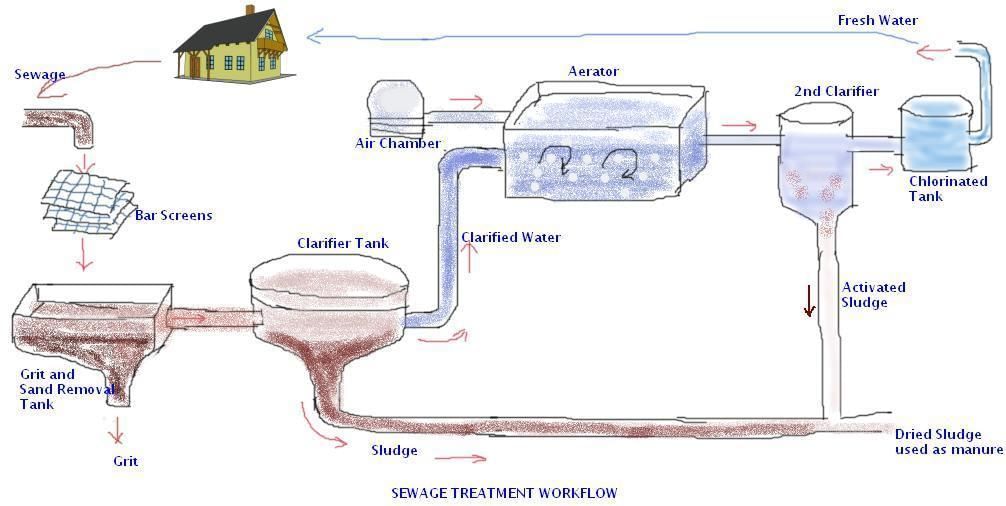Class 7 Exam > Class 7 Questions > Describe the steps involved in getting clarif...
Start Learning for Free
Describe the steps involved in getting clarified water?
Verified Answer
Describe the steps involved in getting clarified water?
Treatment of wastewater involves physical, chemical, and biological processes, which remove physical, chemical and biological matter that contaminates the wastewater.
Following steps are involved:
1. Wastewater is passed through bar screens which remove large objects like rags, sticks, cans, plastic packets, napkins etc.
2. Water then goes through Grit and Sand removal tank, where sand, grit and pebbles settle down.
3. Water is then allowed to settle in a tank where solids like faeces (called sludge) settle at the bottom and are removed with a scraper. A skimmer removes the floatable solids like oil and grease. Water so cleared is called clarified water. Sludge is used to produce biogas.
4. Clarified water is then passed through an aerator tank where air is pumped into the water. It helps aerobic bacteria to grow which decompose organic matter like human waste.
5. After several hours, the suspended microbes settle at the bottom of the tank as activated sludge. The water is then removed from the top. The dried activated sludge is used as manure.
6. Water is removed from the top and is stored in a tank. The treated water has low level of organic material and suspended matter. It is discharged into a sea, a river or into the ground. Sometimes it is disinfected through chemicals like Chlorine and ozone and then distributed to towns.

 This question is part of UPSC exam. View all Class 7 courses
This question is part of UPSC exam. View all Class 7 courses
Most Upvoted Answer
Describe the steps involved in getting clarified water?
Steps to Get Clarified Water:
1. Filtration:
- The first step in getting clarified water is filtration. This involves passing the water through a series of filters to remove large particles, debris, and impurities. The filters may include sand, gravel, activated carbon, or ceramic membranes.
2. Sedimentation:
- After filtration, the water undergoes sedimentation. During this process, the water is left undisturbed in a tank or basin, allowing suspended particles to settle at the bottom. The clear water is then carefully decanted or siphoned off, leaving behind the settled particles.
3. Coagulation:
- Coagulation is the next step in the process of clarifying water. Chemical coagulants such as aluminum sulfate or ferric chloride are added to the water to destabilize suspended particles and allow them to clump together. These particles form larger, easier-to-remove flocs.
4. Flocculation:
- Flocculation involves gently stirring the water to encourage the formation of larger flocs. This helps the particles to come together and settle out more easily during the next step of the process.
5. Clarification:
- Once the flocs have formed, the water is allowed to settle again. The flocs settle at the bottom of the tank, leaving clear water at the top. This clear water is then carefully removed, leaving behind the settled particles.
6. Disinfection:
- The final step in the process of getting clarified water is disinfection. This involves the addition of chlorine or other disinfectants to kill any remaining bacteria, viruses, or other harmful microorganisms. This ensures that the water is safe for consumption.
By following these steps, water can be effectively clarified and made safe for drinking and other uses.
Attention Class 7 Students!
To make sure you are not studying endlessly, EduRev has designed Class 7 study material, with Structured Courses, Videos, & Test Series. Plus get personalized analysis, doubt solving and improvement plans to achieve a great score in Class 7.

|
Explore Courses for Class 7 exam
|

|
Similar Class 7 Doubts
Describe the steps involved in getting clarified water?
Question Description
Describe the steps involved in getting clarified water? for Class 7 2024 is part of Class 7 preparation. The Question and answers have been prepared according to the Class 7 exam syllabus. Information about Describe the steps involved in getting clarified water? covers all topics & solutions for Class 7 2024 Exam. Find important definitions, questions, meanings, examples, exercises and tests below for Describe the steps involved in getting clarified water?.
Describe the steps involved in getting clarified water? for Class 7 2024 is part of Class 7 preparation. The Question and answers have been prepared according to the Class 7 exam syllabus. Information about Describe the steps involved in getting clarified water? covers all topics & solutions for Class 7 2024 Exam. Find important definitions, questions, meanings, examples, exercises and tests below for Describe the steps involved in getting clarified water?.
Solutions for Describe the steps involved in getting clarified water? in English & in Hindi are available as part of our courses for Class 7.
Download more important topics, notes, lectures and mock test series for Class 7 Exam by signing up for free.
Here you can find the meaning of Describe the steps involved in getting clarified water? defined & explained in the simplest way possible. Besides giving the explanation of
Describe the steps involved in getting clarified water?, a detailed solution for Describe the steps involved in getting clarified water? has been provided alongside types of Describe the steps involved in getting clarified water? theory, EduRev gives you an
ample number of questions to practice Describe the steps involved in getting clarified water? tests, examples and also practice Class 7 tests.

|
Explore Courses for Class 7 exam
|

|
Suggested Free Tests
Signup for Free!
Signup to see your scores go up within 7 days! Learn & Practice with 1000+ FREE Notes, Videos & Tests.

























